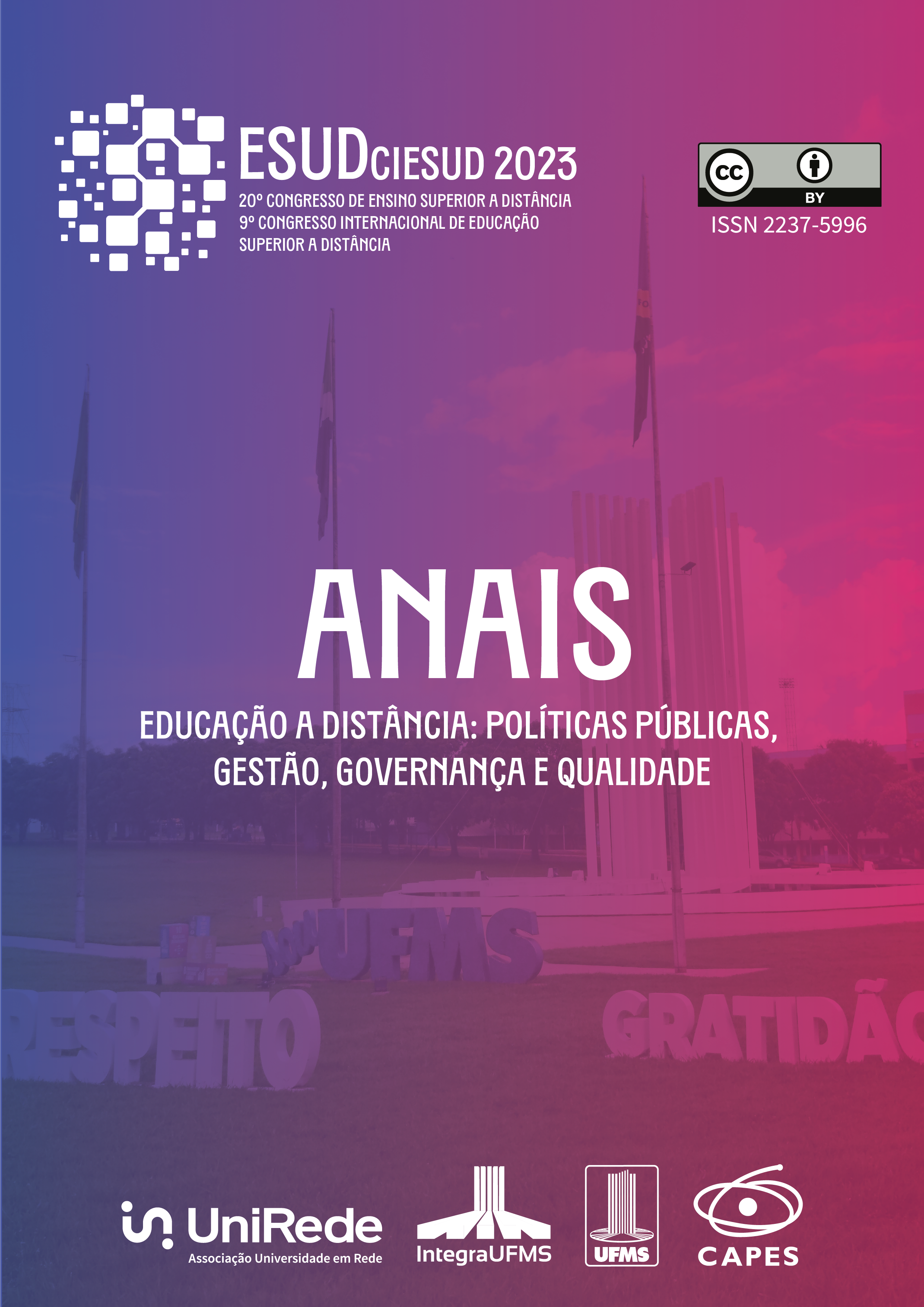O PAPEL DO TUTOR
UM ESTUDO DE CASO DE IMPLEMENTAÇÃO DA EAD
Palavras-chave:
Educação a distância, Práticas educacionais, Ensino superiorResumo
O processo educacional passou por mudanças nos últimos anos, avançando exponencialmente, especialmente com o ensino superior à distância, resultando na necessidade de mudanças na forma de produzir práticas pedagógicas. Diante dessa situação, a pesquisa teve como objetivo realizar uma análise crítica acerca do papel do Tutor na educação a distância em uma Instituição de Ensino Superior em fase final de implementação desta modalidade. Especificamente, também se buscou: (i) realizar um levantamento bibliográfico sobre a implantação da educação a distância nas IES; (ii) obter insights acerca do papel da tutoria com base em indicadores dimensionais do Instrumento de Avaliação de Cursos INEP/MEC; (iii) analisar as estratégias definidas pela coordenação para o pleno funcionamento da educação à distância; e (iv) comparar as funções direcionadas a tutoria na instituição de ensino objeto do estudo com as disposições literárias. Os resultados do estudo de caso demonstram que a instituição de ensino investiu na metodologia de ensino a distância (EaD) com o objetivo de oferecer um ensino de qualidade a um público mais abrangente, auxiliando na disseminação da educação de nível superior, sendo o sucesso do projeto um produto de uma gestão eficiente e do compromisso compartilhado entre os atores envolvidos. A infraestrutura tecnológica é destacada pela gestão como fundamental para o êxito da EaD, com investimentos em plataformas digitais, enquanto o material didático é produzido e adaptado pelos tutores para atender às necessidades específicas dos estudantes, que além da produção, análise e revisão dos conteúdos, desempenham um papel essencial na gestão da EaD, manuseando as tecnologias, dispondo as atividades pedagógicas, colaborando com os professores e coordenadores e fornecendo suporte aos alunos.
Referências
BRANSKI, R. M.; ARELLANO, R.; FRANCO, C.; LIMA JR, O. Metodologia de estudo de casos aplicada à logística. In: Congresso de Pesquisa e Ensino em Transporte. Anais... Conference: XXIV ANPET, Salvador, 2010.
BRASIL. Referenciais de Qualidade para Educação Superior a Distância. BRASIL/MEC/EAD. 2007. Disponível em: https://link.ufms.br/UBQSs. Acesso em: 25 fev. 2023.
CARVALHO, C A. Gestão da infraestrutura e organização tecnológica em educação a distância. São Paulo: Editora Senac, 2020.
GIL, A. C. Como Elaborar Projetos de Pesquisa. 5ª ed. São Paulo: Atlas, 2010.
HANNA, D. E. Organizational Models in Higher Education, Past and Future. In: Moore, M. G.; Anderson, W. G. (Orgs.). Handbook of Distance Education. New Jersey: Lawrence Erlbaum Associates, 2003.
HOLANDA, M. J. B.; PELEGRINELLI, G. Atores da modalidade a distância: os tutores e sua qualificação para o sucesso da EAD. Revista Plurais-Virtual, v. 11, n. 1, 2021.
KAMINSKI, C.; STOLTZ, T. Educação a distância: rediscutindo o papel do tutor. Revista Intersaberes, vol. 10, n. 21, p. 561- 576, set./dez., 2015.
MAGALHÃES, P. H. V.; AJEJE, M. E.; LOPES, M. C. G. Implantação do setor de educação a distância em uma instituição de ensino superior privada. In: 14º Congresso Internacional ABED de Educação a Distância. Anais... 14 CIAED, setembro, 2008.
MARCONI, M. A.; LAKATOS, E. M. Metodologia do trabalho científico: procedimentos básicos, pesquisa bibliográfica, projeto e relatório publicações e trabalhos científicos. 7ª. Ed. São Paulo: Atlas, 2011.
OLIVEIRA, A. T. E. et al. Ferramentas e estratégias de interação e comunicação na prática da tutoria em EaD. Evidência, Araxá, v. 13, n. 13, p. 71-85, 2017.
PAIXÃO, L. E. S. A interação na educação a distância. (Dissertação de Mestrado). Universidade Federal de Santa Catarina. Programa de Pós-Graduação em Engenharia de Produção. Florianópolis, 2002.
PAULA, K. C.; FERNEDA, E.; CAMPOS FILHO, M. P. Elementos para implantação de cursos à distância. Colabor@ Revista Digital da CVA-Ricesu, v. 2, n. 7, mai., 2004.
PIMENTEL, F. S. C. Interação online: um desafio da tutoria. Clube dos autores, 2011.
SALVUCCI, M.; LISBOA, M. J. A.; MENDES, N. C. Educação a Distância no Brasil: Fundamentos legais e implementação. RBAAD, vol. 11, 2012.
SARAIVA, K. Educação a distância: outros tempos, outros espaços. Ponta Grossa: Editora UEPG, 2010.
TORRECILLAS, G. L. S. Educação a distância em uma instituição de ensino superior: estudo das barreiras e do nível de satisfação encontrados no processo de implantação. Universidade de Brasília. Faculdade de Economia, Administração, Contabilidade e Ciência da Informação e Documentação. Brasília, DF. 2007.
Downloads
Publicado
Como Citar
Edição
Seção
Licença
Copyright (c) 2024 Alison Silva Ferreira, Antonio Ferreira Neto, Amauri Dias de Moura, Ana Cláudia Dias Ribeiro

Este trabalho está licenciado sob uma licença Creative Commons Attribution 4.0 International License.
O evento utiliza como base a Licença Creative Commons - Atribuição 4.0 Internacional, pois acredita na importância do movimento do acesso aberto nos periódicos científicos, como Open Archives Initiative.
Ao submeter um texto ao evento os autores concordam com os seguintes termos:
- Os autores concordam em licenciar os trabalhos aceitos para publicação sob a Licença Creative Commons - Atribuição 4.0 Internacional.
- Com o licenciamento em CC-BY 4.0, os autores mantém os direitos intelectuais sobre o texto e concedem ao evento o direito de primeira publicação.
- Os autores concordam em autorizar o envio e indexação dos textos de sua autoria em bases de dados e portais de informação académica e científica.
- Os autores têm permissão e são estimulados a publicar e distribuir seu trabalho online, em repositórios institucionais, em páginas pessoais e redes sociais acadêmicas, após o processo editorial, desde que sejam respeitadas as formas de licenciamento e apresentação do texto, além da indicação do local de origem de publicação, no caso, o link para o sistema de publicação do evento.
- Os autores dos trabalhos publicados no evento são expressamente responsáveis de direito por seu conteúdo.
- Todos os trabalhos submetidos ao evento que possuírem em seu corpo imagens, fotografias, figuras em que estejam registradas imagens de seres humanos, devem vir acompanhados de Termo de Autorização de Uso de Imagem, do membro participante da imagem e, no caso de crianças, dos familiares das crianças expostas, com dados e assinatura dos mesmos.





